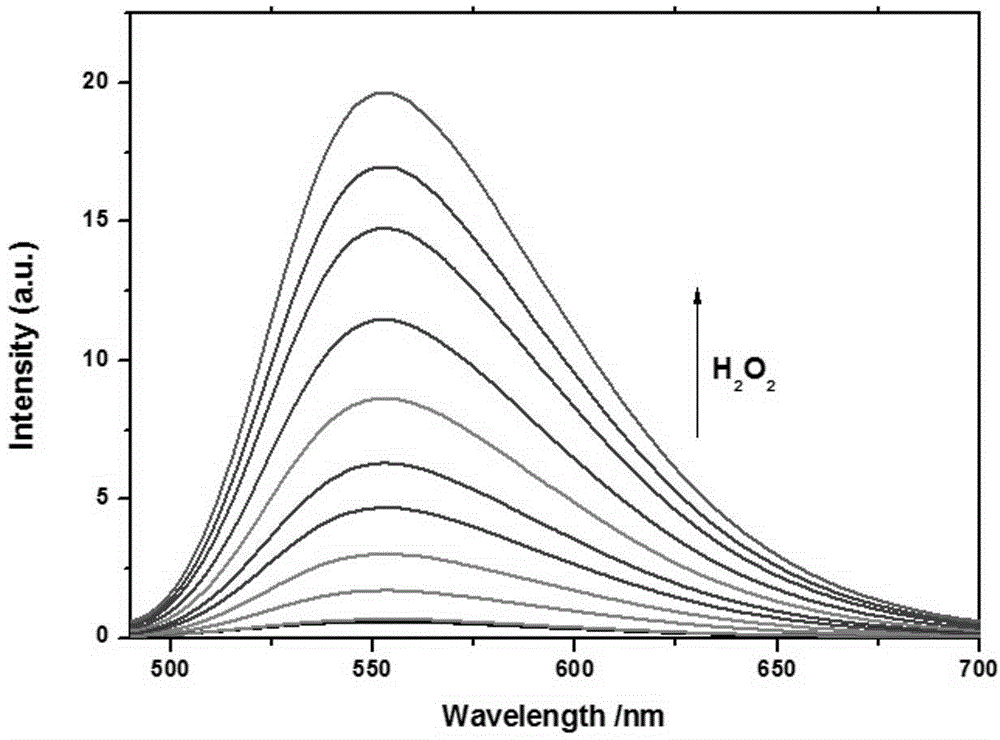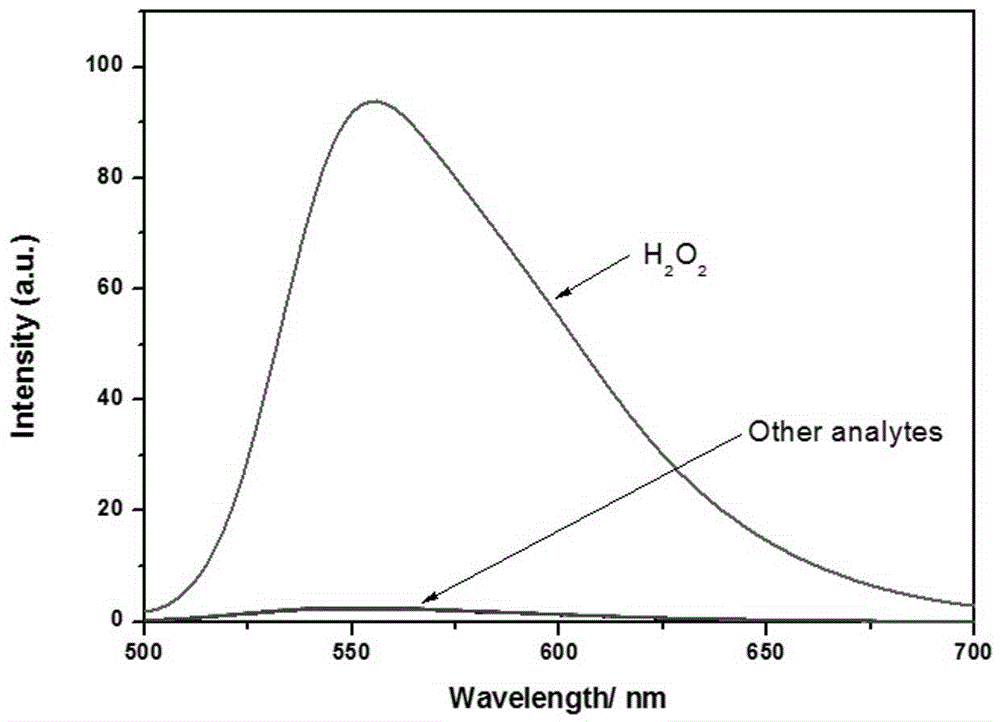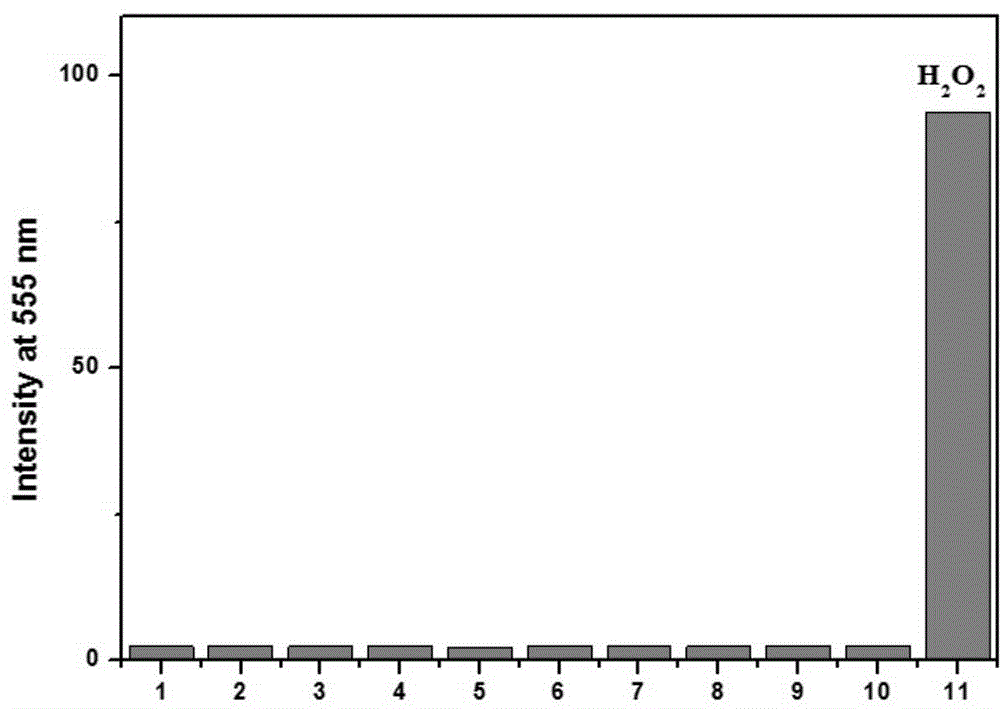Application of fluorescent probe to hydrogen peroxide molecule detection
A fluorescent probe and hydrogen peroxide technology, applied in the field of analytical chemistry, can solve the problems of inability to detect hydrogen peroxide, lack of hydrogen peroxide probes, lack of targeting in detection, etc., and achieve strong and broad resistance to other molecular interference. Application prospect, high coincidence rate effect
- Summary
- Abstract
- Description
- Claims
- Application Information
AI Technical Summary
Problems solved by technology
Method used
Image
Examples
Embodiment 1
[0026] 1) Synthesis of Compound 1:
[0027]
[0028] Dissolve 4-bromo-1,8-naphthalic anhydride (2.77g, 10mmol, 1eq) and N-(2-aminoethyl)morpholine (1.3mg, 10mmol, 1eq) in 50mL of ethanol, under nitrogen protection, Heat to reflux at 100°C and react for 5 h. Use a TCL plate to detect the reaction. After the reaction is complete, extract with ethyl acetate, dry over anhydrous sodium sulfate, concentrate, and separate with a silica gel column. The silica gel particle size is 200-300 mesh, and the eluent ratio is methanol / dichloromethane =1:40, the yield is 80%.
[0029] 2) Compound Lys-H 2 o 2 Synthesis:
[0030]
[0031] Compound 1 (500 mg, 1.29 mmol, 1 eq), pinacol diboronate (688 mg, 1.93 mmol, 1.5 eq) and potassium acetate (378 mg, 3.86 mmol, 3 eq) were dissolved in 20 mL of 1,4-di Add bis(diphenylphosphino)ferrocenepalladium chloride (94.4 mg, 0.013 mmol, 0.1eq) to the oxygen hexane, under nitrogen protection, heat to reflux, react for 10 h, check the reaction wit...
Embodiment 2
[0033] Compound Lys-H 2 o 2 Changes of Fluorescence Spectrum of Hydrogen Peroxide Fluorescent Probe with Increase of Hydrogen Peroxide Equivalent
[0034] Get the Lys-H that embodiment 1 prepares 2 o 2 The hydrogen peroxide fluorescent probe was dissolved in N,N-dimethylformamide (DMF) to make a 1mmol / L stock solution. Take 30μL from the stock solution and add it to a 5mL centrifuge tube, add different equivalents (0-80 eq) of hydrogen peroxide standard solution, use PBS buffer solution (0.1mol / L, pH=7.5) and DMF volume ratio of 1 :1 solution was diluted to 3 mL, and its fluorescence properties were measured. , using 410 nm as the excitation light, the fluorescence spectrum is as figure 2 shown. Depend on figure 2 It can be seen that the fluorescence gradually increases with the increase of hydrogen peroxide equivalent.
Embodiment 3
[0036] Compound Lys-H 2 o 2 Selectivity of Hydrogen Peroxide Fluorescent Probes to Different Molecules or Ions
[0037] Take 30 μL from the fluorescent probe stock solution in Example 2 and add it to a 5mL centrifuge tube, add equimolar amounts of competing molecular standard solutions, one of which is added with equimolar amounts of hydrogen peroxide standard solution, and after 30 minutes, the concentration is measured at 410 nm To detect the change of the fluorescence emission spectrum of the solution by excitation light, by image 3 with Figure 4 It can be found that other metal ions on the compound Lys-H 2 o 2 The fluorescence has almost no effect, and the addition of hydrogen peroxide solution makes the compound Lys-H 2 o 2 fluorescence was significantly enhanced.
PUM
 Login to View More
Login to View More Abstract
Description
Claims
Application Information
 Login to View More
Login to View More - R&D
- Intellectual Property
- Life Sciences
- Materials
- Tech Scout
- Unparalleled Data Quality
- Higher Quality Content
- 60% Fewer Hallucinations
Browse by: Latest US Patents, China's latest patents, Technical Efficacy Thesaurus, Application Domain, Technology Topic, Popular Technical Reports.
© 2025 PatSnap. All rights reserved.Legal|Privacy policy|Modern Slavery Act Transparency Statement|Sitemap|About US| Contact US: help@patsnap.com



